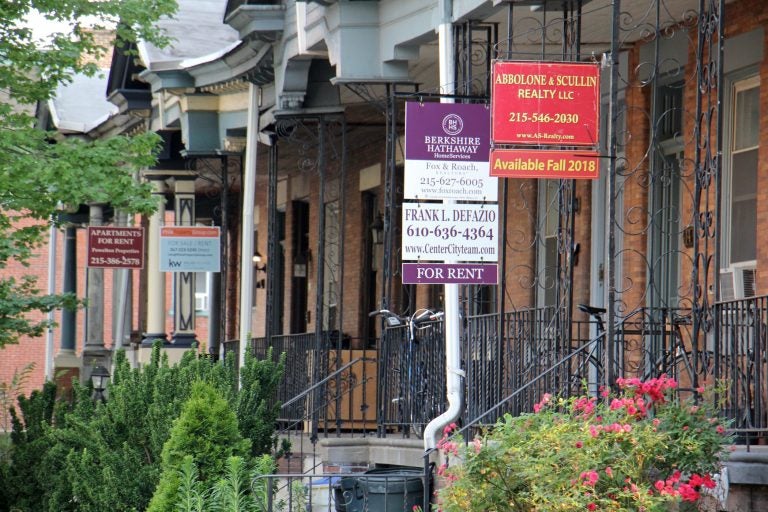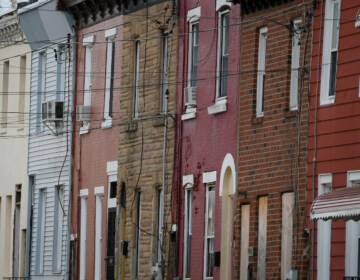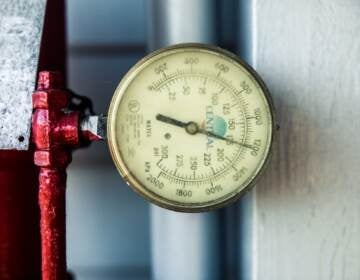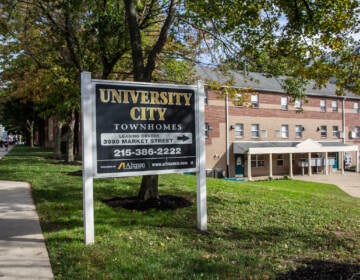Philly housing costs rising faster for poor and middle class than for the wealthy
Housing costs are growing for low-income renters but not higher-income renters and homeowners, worsening income inequality in the Philadelphia region and nationally.

Rowhomes at 34th and Spring Garden Street for sale or rent. (Emma Lee/WHYY)
As the Philadelphia region’s poorest residents spend more to keep a roof over their heads, the area’s wealthiest residents are spending less, according to new research from economists at Apartment Life, a San-Francisco-based real estate company.
“If you’re well-off already, you’re income seems to be growing faster. But if you’re not doing so well, your housing costs are outpacing your income and making it even harder to get ahead,” said Igor Popov, the company’s chief economist.
Between 2007 and 2018, housing costs for households in the region earning less than the national median income grew 8%. They didn’t rise at all for households earning above that mark, according to census data crunched by the company. The median household income was $61,400 in 2017.
Philadelphia and other big cities have seen an influx of wealthier residents moving in. That’s hiked the demand for higher rent housing and effectively flooded the market with sleek and shiny multi-family properties.
With less competition for these units, prices dropped, said Popov. At the same time, most big cities continue to have a dearth of affordable housing options for residents with smaller paychecks.
Additionally, people struggling to make ends meet aren’t spending substantially less on rent than people who earn bigger paychecks, even though they’re making a lot less.
“Housing costs just don’t vary that much,” said Popov. “For all intents and purposes, you’re paying the same amount in housing if you’re in the bottom quartile as if you were in the very middle of the distribution.”
This is not a new trend. The difference is that it’s getting worse as income inequality — the gap between rich and poor — widens.
In 2008, the metro area’s wealthiest residents earned more than 12 times what the area’s poorest residents earned, according to the study. In 2017, those wealthy residents made 17 times more than the poorest residents.
Housing advocates say that’s a dangerous dynamic that could push low-income residents into homelessness or out of town — and make places like Philadelphia far less diverse than it is now.
“We could end up pushing people into Camden, into Chester, you know, into Croyden — these little tiny areas that don’t have the social services, that don’t have the capacity. And again, we’re just kind of exporting the burden to cities that can’t afford to turn people away and afford to support them either,” said Akira Rodriguez, who teaches urban planning at the University of Pennsylvania.
Phyllis Chamberlain, executive director of the Housing Alliance of Pennsylvania, said residents may be pushed into substandard housing — in Philadelphia or elsewhere — with potentially lifelong impacts.
“There’s evidence that children who experience homelessness and who have to move often have higher baseline symptoms of depression and anxiety. There’s data that shows children living in a crowded household are actually less likely to graduate from high school,” said Chamberlain.
Their solution is simple: more investment in affordable housing projects and more housing subsidies for low-income residents.
—
 WHYY is one of 22 news organizations producing Broke in Philly, a collaborative reporting project on solutions to poverty and the city’s push towards economic justice. Follow us at @BrokeInPhilly.
WHYY is one of 22 news organizations producing Broke in Philly, a collaborative reporting project on solutions to poverty and the city’s push towards economic justice. Follow us at @BrokeInPhilly.
WHYY is your source for fact-based, in-depth journalism and information. As a nonprofit organization, we rely on financial support from readers like you. Please give today.







